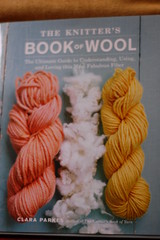First, the facts:
Author: Clara Parkes
Published by: Potter Craft, 2009
Pages: 207
Type: Lots and lots of information about wool, as well as some great patterns.
Chapters:
1. What is Wool?
2. From Pasture to Pullover–Turning Wool into Yarn
3. Meet the Breeds
4. Plays Well with Others
5. Patterns
Pattern Size Range: It varies
The In-Depth Look:
How many times have you heard these excuses?
“I can’t wear wool, it’s too itchy.” (Not if it’s the right kind, it’s not.)
“Wool is just too much trouble, you can’t put it in the washing machine.” (What? Letting something soak is too hard? Haven’t you heard of Superwash?)
“I’m allergic to wool, it always gives me a rash.” (Often–though not always–the irritant is not the wool, but the chemicals used in processing.)
Welcome to the world of people who love wool but are forever trying to convince everyone else who remembers that itchy sweater they had to wear as a child that yes, wool really IS a good, soft, useful, miracle fiber.
How can you resist a book that begins, “I have always loved wool–I mean really and truly loved it, like Claude Monet loved his Giverny and Julia Child loved her butter. Discovering a new wool yarn, smelling it, touching it, dreaming of what I can do with it, knitting and washing a swatch and seeing how it transforms … those things make me feel complete and fulfilled.”
Unlike Clara’s first book, about yarn in general, this book is all about wool. Specifically wool. Nothing but wool–except for some of the fibers that can be blended with wool.
You might be asking yourself, “But why? Didn’t she cover this already?” And yes, it’s true, she DID talk about wool in her first book, but not in-depth, not like this.
Because THIS book is in-depth! She starts off talking about the different kinds of wool.
- How their crimp affects the kind of yarn they will make.
- How wools with sheen and luster are different than ones with more of a halo effect.
- How staple length can alter the way your yarn wears once it’s been knitted into a garment.
- Why you might want to choose one type of wool over another.
- Why manufacturers blend different types of wool together to get that “100% wool” label that doesn’t really tell a handknitter or spinner very much at all.
All this is even before you get to an overview of different sheep breeds and the types and uses of fleece each one has. Not that she covers every sheep breed, of course. That would take another three volumes (I’m guessing), but she does cover the “highlights.” She talks specifics about some of the more familiar breeds (Merino. Bluefaced Leicester, Jacob, Cormo, and so on), but she also makes sure that you, the reader, know what you’re looking FOR when judging a fleece or fiber. Just knowing whether a breed has short staple fleece rather than long staple can affect your decisions.
Then, once you’ve covered the history of wool, its types, its uses, and its breeds (not to mention the benefits of blending wool with other fibers)–you get to start playing. That’s where the patterns come in.
It shouldn’t surprise you to know that each pattern specifies the type of wool you should use. Standard, commercial yarns are mentioned, but she tells you what KIND of wool/blend you should be using–determined by all the factors already discussed in the book.
The patterns cover a nice range–hats, mittens, socks (7 patterns altogether), sweaters (5 patterns, or, well, 8 with the “three bears” set), shawls and scarves (5 patterns), even a tote bag and a pillow. There are things to make for adults, for children, for men, for women. Each pattern is designed specifically for the type of yarn being used, so the halo of the Shetland wool is put to good use, or the sheen of a merino/silk blend. Nor should it surprise you that she assembled some of the best designers around, either. Designers who can truly appreciate and understand the qualities of the wool they were working with.
All in all, this book is a fantastic examination of one of my favorite, misunderstood fibers. And, nobody could have done it better than Clara Parkes, whose writing is always entertaining. It’s not easy to make the description of a chemical components of wool interesting, but she accomplishes it with apparent ease. (“Wool is a natural protein fiber that begins its life deep in the hair follicles of a sheep’s skin. Carbon, hydrogen, oxygen, nitrogen, and sulfer come together to form long polypeptide chains of 19 amino acids that grow out of each follicle and become the shafts of fiber that we see.”)
Now, if you’re looking for an overview of different kinds of yarn, you should start with her first book. If you’re simply looking for a book of patterns–half of this book will disappoint you. But, if you want to know more about why this fiber is a natural miracle fiber, and all the different ways itcan be shorn, spun, dyed, plied, draped, and used for vastly different results–this book is a gold mine.
This very worthy second book is available at Amazon.com for under $20
Want to see bigger pictures? Click here.

Other posts for this author:



Comments on this entry are closed.